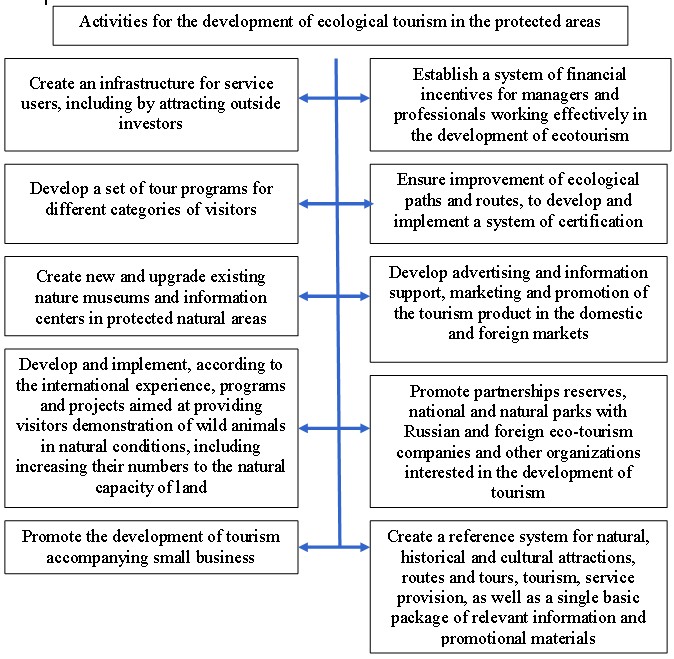РАЗВИТИЕ ЭКОЛОГИЧЕСКОГО ТУРИЗМА В ОСОБО ОХРАНЯЕМЫХ ПРИРОДНЫХ ОБЛАСТЯХ РОССИИ
Aннотация
В статье рассматриваются перспективы развития экологического туризма в особо охраняемых природных территориях Российской Федерации: выполнена краткая оценка ситуации в отечественной туристической отрасли, охватывающей период до конца 2014 года – начала 2015 года; представлена статистическая информация об особо охраняемых районах, а также анализируется возможность использования особо охраняемых природных территорий в качестве ресурсной базы для экотуризма. Автор статьи, опираясь на мнения экспертов отрасли, предлагает мероприятия, направленные на внедрение эко-туризма в охраняемых районах, обосновывает практики управления в сфере экотуризма на этих территориях. В статье автор выдвинул определение «эко-туризма», основные проблемы развития экотуризма на охраняемых территориях, предложил стратегию оптимального функционирования экотуризма, принимая во внимание его прибыльность, конкурентоспособность и снижение негативных экологических последствий массового туризма на охраняемых природных территориях.
Ключевые слова: Экотуризм, охраняемые районы *Исследование выполнено в рамках реализации Программы стратегического развития ФГБОУ ВПО «СПбГЭУ» на 2014-2016 гг. Проект 2.2.3. «Научно-исследовательское и образовательное сопровождение развития туристической индустрии на базе научно-образовательного центра социально-экономического и гуманитарного развития международного и регионального туризма»
К сожалению, текст статьи доступен только на Английском
In 2014 – early 2015, the Russian tourism industry saw significant changes due to the bankruptcy of a number of the largest tour operators, as well as a significant weakening of the national currency. Under these conditions, the sphere of domestic tourism is on the verge of collapse. During the first 20 days of January 2015, the Federal Register of tour operators decreased by 165 companies. And over the period of March 16-23, 2015, in accordance with the orders of the Federal Tourism Agency, there were excluded more than 400 companies from the Federal Register [1]. In these conditions, a qualitative change in the situation can create competitive tourism products focused on the domestic market. One of the most promising areas of development is eco-tourism. Its development in foreign countries is closely related to protected areas. The author of the article set a goal – to conduct a theoretical justification of the possibility of using protected areas (PA) as a basis for the development of ecological tourism in Russia.
The methodological and theoretical work formed the basis of the works of Russian and foreign scientists in the field of tourism and tourist activities, economic and environmental legislation and legal documents regulating the activities of organizations of tourism business [8-9]. The methodology used by the author is based on the use of scientific methods of the system approach, expert assessments, and analysis of the press.
Eco-tourism is such a natural-oriented type of tourism that involves traveling to places with the natural environment relatively undisturbed by anthropogenic impact, in order to get an idea of the cultural and ethnographic and natural features of the terrain, without compromising the integrity of the ecosystem by the traveler, and traveling in accordance with the principles of environmental sustainability, thus making the protection of the natural resources beneficial to local people [2-5].
Resources for this type of economic activity serve the community of locally-placed environmental objects of interest for potential ecotourists. For that purpose, it is expedient to use specially protected areas, nature sanctuaries, and natural preserves. Specially Protected Areas (PAs) – the land, water surface and air space above them, with natural complexes and objects that have a special environmental, scientific, cultural, aesthetic, recreational and health significance, withdrawn by a public authority in whole or in a part from the economic use and for which was set a special protection mode [6].
The need of developing eco-tourism and the role played by PA in this area has been repeatedly emphasized by the Government of the Russian Federation. In accordance with the plan of action to implement the development strategy of the tourism industry of the Northwestern Federal District of the Russian Federation for the period until 2015, the Office of the Presidential Envoy to the Northwestern Federal District have developed some activities for the development and implementation of the concept of ecotourism development in the North West of Russia for the period up to 2015, which includes the following priority actions:
1. To develop and implement the development activities on the territory of the Northwestern Federal District network of protected areas (national parks, sanctuaries, reserves), to provide conditions for sustainable development of ecotourism and other forms of nature tourism.
2. Development and implementation of measures for the development of tourism infrastructure on PA (parking lots, trails, sites for observation of animals and birds, etc.), as well as the surrounding areas (hotels, catering facilities, parking lots, etc.).
3. Development of general regional tourist routes related to visiting national parks, reserves, etc [7].
However, the development of eco-tourism on the territory of protected areas is complicated by the following factors:
- today, the development of cognitive (ecological) tourism in protected natural areas is carried out in accordance with the concept of development of specially protected natural territories of federal significance for the period up to 2020;
- development of complexes of tour programs for different categories of visitors, including organizing a demonstration of wild animals in their natural habitat;
- creating nature and hiking trails, lookouts and places of wildlife viewing; creation and modernization of museums and information centers for visitors; assessment of maximum permissible loads and identifying ways to minimize the negative impact of tourism on the natural ecological system.
With unique objects of the show, both natural and cultural, historical, protected areas can form the basis for the formation of large tourist centers. At the same time, taking into account the international experience relevant to the tourist infrastructure (hotels, etc.), it should preferably be located adjacent to the sites of Protected Areas not burdened with constraints related to special protection [8].
On the territory of the Russian Federation, there is a fundamental opportunity for the development of eco-tourism through its integration in the protected areas, but you must take the following actions (fig. 1).

Fig. 1. Events on ecotourism development on the territory of the Russian PA
Рис. 1. Мероприятия по развитию экотуризма на особо охраняемых территориях России
Now, there are 14,329 PAs, including 490 federal protected areas, 11531 – of regional significance, in 2308 – of local importance located in the Russian Federation. The vast majority are natural monuments and national nature reserves, including spas and resorts, arboretums and botanical gardens, and others [9].
In recent years, many protected areas both in Russia abroad see the increasing flow of visitors (especially the «bush» tourists). Many of the protected areas were not ready, on the one hand, to ensure the needs of the growing number of eco-tourists, and on the other, to guarantee the safety of tourist activities arranged in natural resources. In each region, the development of eco-tourism needs a realistic look at the possibility of its implementation, its profitability and competitiveness as well as the need to scientifically evaluate the optimal level of tourism for the area and then develop a strategy leading to the achievement of this level.
This strategy should guide the development of eco-tourism in a way that: a) it does not affect natural systems, b) there are mechanisms to increase employment of local residents, c) there is an opportunity to increase revenues of environmental agencies and local communities, g) development of environmental education. With this development strategy, local and regional governments and PAs will be able to minimize the costs of eco-tourism and maximize its benefits.
The main stages of the development of ecotourism on the territory of protected areas are presented on Figure 2.

Fig. 2. The main stages of strategy development of ecotourism in the region
Рис. 2. Основные этапы разработки стратегии экотуризма в регионах
In order to develop effective environmental tourism without harming the environment, in addition to the use of appropriate technologies, there should be met three additional conditions: 1) the availability of sufficient information (including databases) on natural resources and their use at tourism regional authorities and administrations of protected areas; 2) provision of additional resources (human, financial, image, and so on.) is sufficient to develop and improve the technologies of management in tourism; 3) the cooperation of the regional administration and the administration of protected areas with ecotourists and representatives of the tourist industry. All these conditions are equally important in order to ensure compliance with environmental standards in the implementation of tourist activities. In addition, the management of eco-tourism should be based on particular features of various target groups of tourists and other stakeholders, as well as on other components of tourist activities. Effective management of eco-tourism involves the use of the following methods for management of tourism in the region:
1. Zoning, which is based on the fact that different parts of protected areas, especially large ones, usually have different environmental value and / or can withstand varying degrees of use. Within Pas, they usually distinguish the following types of zones: strict protection (vulnerable ecosystems); limited use; temperate mode of use by tourists; intensive use; infrastructure.
2. Managing a flow of visitors is intended to address such issues as: excessive recreational capacity of the territory (the quantitative aspect); inappropriate behavior of visitors (qualitative aspect). In order to regulate the number of ecotourists in the region it is advisable to use the following two control methods: the concentration of visitors in places with higher recreational capacity; the flow distribution of ecotourists in the less used areas and the seasonal flow distribution.
3. Implementation of personnel training programs. The participants of these programs can be the staff of the protected area, local guides and tour operators specializing in ecotourism.
4. Regulation of activities of the private sector. Such regulation implies control over the environmental impact of tourism infrastructure (accommodation facilities, restaurants, shops, etc.), as well as the activities of those who provide services in the tourism sector (tour operators, guides, etc.).
To ensure the environmentally friendly operation of tourist infrastructure the protected areas may issue special licenses and concessions based on the assessment of the environmental quality of work of the applicants. The agreement concluded between the management of protected areas and the private sector should provide revision or denial of a license or concession in case of violations of environmental regulations. Abroad, in order to better assess the activities of tourist organizations (hotels, tour operators, etc.) and support to companies, whose activities are environmentally friendly, there is a popular method of using environmental trademarks and brands, as well as voluntary certification.
5. Establishing partnerships, using the mechanisms of PAs. Regional authorities together with the administration of protected areas, local communities and other stakeholders participating in the development of ecotourism develop working agreements (in foreign practice used concession agreement). Such agreements include the issue of permits (patents) for the provision of services for PAs tourists, like food, accommodation and transport services, provision of guides, the sale of certain goods. The government may impose additional terms for the concessions in order to perform additional tasks (e.g., increase local employment or sales of locally produced goods). Another mechanism of self-financing of protected areas is the system of deductions from income for the activities and products of protected areas. For example, it may be a permission of PAs in other organizations selling books, photographs, films, souvenirs, created in areas of ecotourism. Percentage of these activities may be charged as a contribution to the maintenance of the protected area. Of the utmost importance is the establishment of adequate contributions (prices) for visiting protected areas. PAs are often set to decrease the amount of the input contributions that do not match the actual solvency of visitors. It is appropriate to establish different entrance fees for foreign tourists, the inhabitants of the country, as well as local residents (it is generally advisable to exempt the latter from payment for visiting protected areas). Regional authorities and the administration of protected areas should pay particular attention to establishing a good working relationship with the most environmentally friendly tour operators and organizations based on: 1) their careful selection and understanding of the problems of environmental protection, as well as the desire to actively participate in protection of the Environment; 2) training organizations specializing in ecotourism [10].
Despite the fundamental possibility for the development of these areas through the implementation of the plan of activities, as well as compliance with the activity of the government programs, conducting eco-tours to the most protected areas is still a very promising direction requiring significant time and cost.
The minimum contribution required from the directorates of protected areas is the development of environmental trails and nature trails. Even so insignificant, in the overall scale, changes can significantly increase the attractiveness of protected areas as a basis for the development of eco-tourism and attract thousands of visitors to protected areas, that with proper control will enhance the socio-economic indicators in the region, the growth of its prestige and the development of domestic competitive tourism products.
















Список литературы
1. Network edition «Interfax – Tourism», 2015, URL: http://tourism.interfax.ru
2. National Strategy for Ecotourism Australia. Department of Tourism, Canberra. 1992.
3. Ross S., Wall G. Evaluating Ecotourism the Case of North Sulawesi, Indonesia, Indonesia, Tourism Management, Vol 20, No 6. 1999. Pp. 673-682.
4. Fennell, D, Article Ecotourism: an introduction by David A. Fennell, Routledge, vol. 7. 1999. Pp 315.
5. Lindberg K., Hawking D. Ecotourism: A Guide for Planners and Managers. Vol. 1. The Ecotourism Society. North Bennington (USA). 1993.
6. Official internet-portal «PA Russia», URL: http://oopt.aari.ru/
7. Action Plan to implement the development strategy of the tourism industry of the Northwestern Federal District of the Russian Federation for the period up to 2015, the Russian Union of Tourism Industry, 2003.
8. Order of the Government of the Russian Federation on May 31, 2014 N 941-r of Moscow «On Approval of the Strategy for the Development of Tourism in the Russian Federation for the period up to 2020».
9. Печерица Е. В. Управление туризма на федеральном, региональном и муниципальном уровнях // Международный научно-исследовательский журнал. № 1-3 (20). 2014. С. 55-56.
10. Гузанов А. А. Management of the ecological tourism in the regions of Russia // Moscow, 2010.